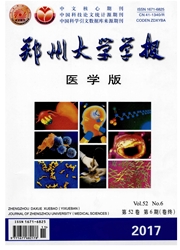

 中文摘要:
中文摘要:
瞄准:为了调查 ghrelin 的保护的效果和机制,对 hypoxia/reoxygenation (H/R ) 的 postconditioning 在人的胃的上皮的房间导致了损害。方法:H/R 损害的模型在胃的上皮的房间线(GES-1 ) 被建立人的胃的上皮的房间。房间被划分成七个组:正常控制组(N) ;H/R postconditioning 组;DMSO postconditioning 组(DM ) ;ghrelin postconditioning 组(GH ) ;D-Lys3-GHRP-6 + ghrelin postconditioning 组(D + GH ) ;capsazepine + ghrelin postconditioning 组(C + GH ) ;并且 LY294002 + ghrelin postconditioning 组(L + GH ) 。3-(4,5-dimethylthazol-2-yl )-2,5-diphenyl tetrazolium 溴化物(MTT ) 试金被用来检测 GES-1 房间生存能力。染色的 Hoechst 33258 uorochrome 和流动 cytometry 被进行决定 GES-1 房间的 apoptosis。Spectrophotometry 被执行决定版本喂奶使脱氢(LDH ) 。Bcl-2, Bax, Akt,和肝糖 synthase kinase (GSK )-3 的蛋白质表示被西方的弄污决定。vanilloid 受体子类型 1 的表示(VR1 ) , Akt 和 GSK-3 被 immunocytochemistry 观察。结果:与 H/R 组相比, GH 组的房间生存能力显著地以一种剂量依赖者方式被增加(55.9%?
 英文摘要:
英文摘要:
AIM: To investigate the protective effect and mechanisms of ghrelin postconditioning against hypoxia/reoxygenation (H/R)-induced injury in human gastric epithelial cells. METHODS: The model of H/R injury was established in gastric epithelial cell line (GES-1) human gastric epithelial cells. Cells were divided into seven groups: normal control group (N); H/R postconditioning group; DMSO postconditioning group (DM); ghrelin postconditioning group (GH); D-Lys3-GHRP-6 + ghrelin postconditioning group (D + GH); capsazepine + ghrelin postconditioning group (C + GH); and LY294002 + ghrelin postconditioning group (L + GH). 3-(4,5-dimethylthazol-2-yl)-2,5-diphenyl tetrazolium bromide (MTT) assay was used to detect GES-1 cell viability. Hoechst 33258 fluorochrome staining and flow cytometry were conducted to determine apoptosis of GES-1cells. Spectrophotometry was performed to determine release of lactate dehydrogenate (LDH). Protein expression of Bcl-2, Bax, Akt, and glycogen synthase kinase (GSK)-3β was determined by western blotting. Expression of vanilloid receptor subtype 1 (VR1), Akt and GSK-3β was observed by immunocytochemistry. RESULTS: Compared with the H/R group, cell viability of the GH group was significantly increased in a dosedependent manner (55.9% ± 10.0% vs 69.6% ± 9.6%, 71.9% ± 17.4%, and 76.3% ± 13.3%). Compared with the H/R group, the percentage of apoptotic cells in the GH group significantly decreased (12.38% ± 1.51% vs 6.88% ± 0.87%). Compared with the GH group, the percentage of apoptotic cells in the D + GH group, C + GH group and L + GH groups significantly increased (11.70% ± 0.88%, 11.93% ± 0.96%, 10.20% ± 1.05% vs 6.88% ± 0.87%). There were no significant differences in the percentage of apoptotic cells between the H/R and DM groups (12.38% ± 1.51% vs 13.00% ± 1.13%). There was a significant decrease in LDH release following ghrelin postconditioning compared with the H/R group (561.58
 同期刊论文项目
同期刊论文项目
 同项目期刊论文
同项目期刊论文
 The role of nuclear factor-kappa B in the effect of Angiotensin II in the paraventricular nucleus pr
The role of nuclear factor-kappa B in the effect of Angiotensin II in the paraventricular nucleus pr Administration of angiotensin II in the paraventricular nucleus protects gastric mucosa from ischemi
Administration of angiotensin II in the paraventricular nucleus protects gastric mucosa from ischemi 期刊信息
期刊信息
